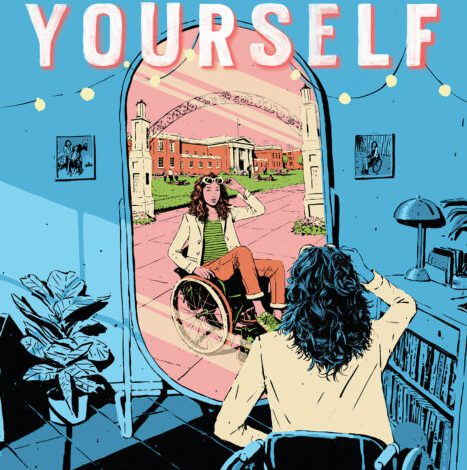Cam Cordes, Harper Jeffries, and Effie Galanos are planning to enjoy their final year of high school at Mill City High in Minnesota. As this trio of young women navigate their senior year, they realize the bitter-sweetness in so many moments—from school dances to lunches off-campus. Wondering how she will survive without her typical support systems at college, Effie especially frets for her future since she is a wheelchair user who has cerebral palsy.
Determined to enroll at a university with a reputable Mass Media and Society Department, Effie wants to help minorities, specifically people who are differently abled, be more visible in mass media, such as magazines and digital spaces where they might see themselves represented. But where is that “right place, if right means scary, exhilarating, [and] freeing” (27)? While she wheels through the world trying to keep things safe and easy, Effie envies people like her older sister, Cora, who go “all in, all the time, double or nothing” (25) and people like Wilder who “grins and bounds down the steps, skipping every other one, his feet so nimble it looks like a complicated dance move” (95). Effie wonders, “What is that like—for your brain to tell your feet to do something complicated, and they do it?” (95).
From her own lived experience as a wheelchair user, Claire Forrest writes Where You See Yourself for all those experiencing their final year of high school and juggling classes along with the stress of the college admissions process. This is a story that will inspire all readers to stand up to systems and the people who put them in place, to find their voices, and to self-advocate so as to effect change. It is also a story that honors young adults or anyone else who is looking for validation, affirmation, or community. After all, every one of us wishes to be seen and to find our people and our place in this grand universe called life.
Because it navigates the challenges for the differently-abled with grace and from knowledge, Forrest’s book deserves a look by the committee that confers the Schneider Family Book Award, which honors an author or illustrator for a book that embodies an artistic expression of the disability experience for child and adolescent audiences. Forrest not only mentions the clonus and “bang snaps” experienced by her protagonist but points out what Effie is expected to sacrifice or give up because she is a wheelchair user.
Furthermore, Forrest makes obvious how much work has yet to be done to ensure equal access since the status quo as well as policies are skewed to favor the majority. In addition to the sensitivity training and awareness components of this book, tucked into its pages are some key morals. My favorites speak to how we can honor our friends by celebrating the changes in their lives, how we tend to complicate friendships with our own insecurities, and how we often erect barriers that aren’t really there. Although they say you can’t be what you don’t see, Effie begins to see and to find her voice.
- Posted by Donna

